Hawaii, putting in the miles
on the Kona Coast.
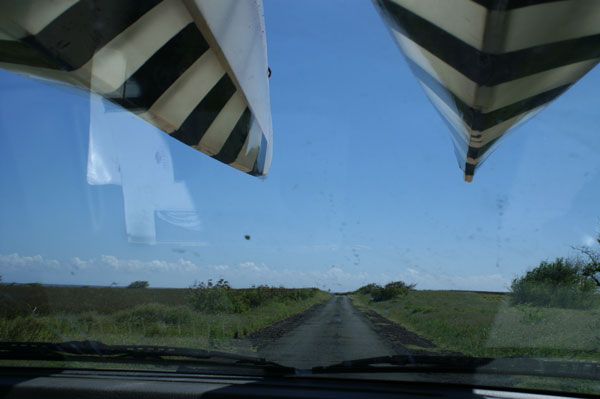
2/12/07 - 2/17/07
Rich drives me to South Point where currents and winds from the
Kau Coast and the Kona Coast accelerate and collide in an impressive
washing machine. On some
days, Rich tells me, the confluence is so violent that the waves stand
up in fifteen foot spikes of water, the whole mess sweeping out toward
Tahiti. We scope the spot from a fascinating cliff called
'broken landing' where Rich tells me to watch the dog (again,
what am I supposed to DO exactly?), and then dives 30 feet down into
the most beautiful blue water I've ever seen. He climbs
back up on a rope.
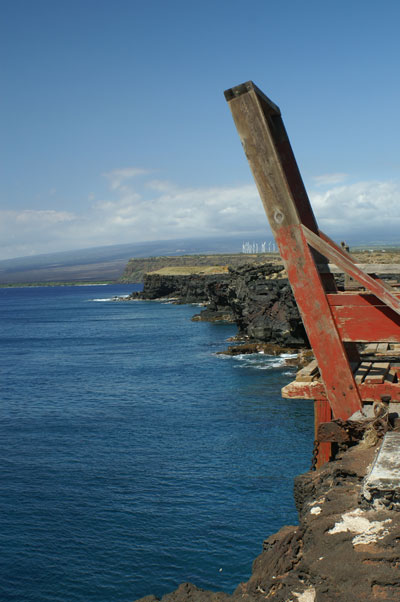
Looking north from Broken Landing.

I
launched my new SC-1 kayak, freshly painted with shark
repellant stripes, into a mild trade wind swept sea, only twelve foot breaking
waves. I rounded South Point and headed north, clinging to the
shoreline and tucking in tight behind low cliffs dropping into the
clearest deep blue
water I've ever seen. The effect was hypnotic and I remember
thinking,"It would be ok to drown in this water."

My
moment of natural awe was quickly replaced with natural terror when
two miles later a fin a little bigger that a dolphins fin surfaces ten
feet in front of
my kayak. My mind grapples, "what is wrong with this fin?".
Three distinct things, it didn't breathe, it didn't dive, and it turned
sideways. SHARK, BIG SHARK the alarm sounded inside me, it
would NOT be ok to be eaten
in this water! I countered the rising panic with a powerful
message
forced backwards through my nerves to the tips of every mollecule and
capilary, DON'T. FREAK. OUT. A dark boil erupts next
to me and then it's gone. Was it a shark? The chances say
not likely, but it was an odd fin that set the stage for how
I would respond were I to see another.
I paddle five miles north from broken landing to a large
natural lava pyramid fronted by a red sand beach and a small dumping
wave. Rich calls this place 'the Great Eye'. It's desolate
and utterly devoid of vegetation. A pair of Humpback whales cruise by
at sunset. I put on
my 'Destination Wear' Kokatat pants and shirt, exquisitely well
designed quick dry garmets that made me feel like a kayaking
commercial. They really are damn comfortable clothes.

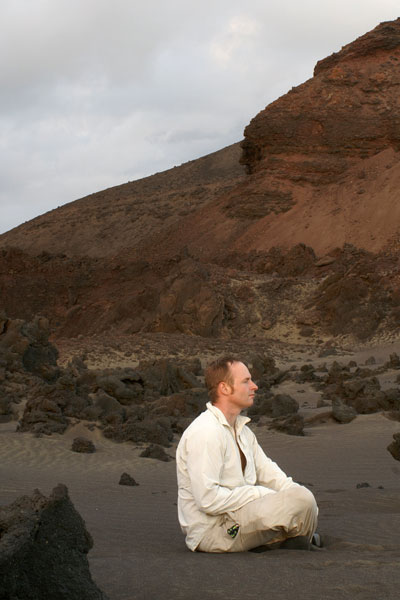
My camera dies completely after this photo. Wind howls across the
beach all
night. I sleep in my hammock tied up against a low lava cliff.
2/13/07
To navigate open coastlines I now prefer a diver's white board
to a chart case and china markers. At night I trace the map for
the next day adding just the information I need. During the day I
track my progress directly on the map, adding notes and using the
backside to write notes from anyone I might meet on the beach or the
water. The system is compact and accurate for point to point
navigation. At night I trace the maps back to my journal.

Morning inventory, day two, I no longer have my second set of
sunglasses, my knife is missing, and my $1000 DSLR camera has given up
the ghost. Not good, the physical currents may be with me but the
'unseen forces' are beginning to flow opposite my course.
At dawn I load the kayak and push
it out through the
surf. It's easier to swim a kayak out in small dumping
surf. The sun rises behind me. Paddling
north along south Kona is alot like touring in parts of Baja. Low
volcanic cliffs, desert scrub, little habitation. The difference
is the half mile wide black lava flows that stretch upwards to the high
slopes of Kiluea, large rivers of hardened molten rock that once
poured down
into the sea every five miles, erasing all vegetation to the
shoreline. The first sign of habitation is the remote Hawaiian
village of Miloli, built directly onto one of these flows it's roads
appear impossibly steep, the front porch of each house is in some cases
the roof of the house below it. It seemed an unlikely choice for
a village except for the small beach that fronts it, a rare gem on
this rock studded coastline.
At 1pm I'd been paddling for
twenty five miles and I was at the edge of my chart where I'd marked,
Hookena 15mi N. There was still plenty of daylight and what was I
going to do all afternoon sitting on a
tiny beach? I decided to paddle for Hookena. A few miles
out to sea I paddle up to a small motor boat piloted by a ragged long
haired white guy in shorts and a dirty flower print shirt.
Surprised to see this apparrition of a kayaker,
he hauls up a single tiny yellow fish on a longline baited with dozens
of hooks before pointing me toward Hookena. I thought back
to the book The Curse of Lono where in this very spot Hunter Thompson
drops a note in a bottle into the sea that reads simply, 'There are no
fish'.
I paddle onward, pleased that after three months of grueling
training I feel strong and comfortable at thirty miles. I'm
precise with my rituals on the water, my hydration pack feeds up
through my spray skirt supplies a steady drip of electrolylte at one
quart per ninty minutes. Every hour and a half I eat a cliff bar
(Cliff bar refused to sponsor my expedition by the way), and every
three hours I
stop for five minutes to consume an energy gel packet and apply
sunscreen. At thirty three miles I run out of food and
water which is a bad thing because as soon as you stop eating and
drinking your body stops burning fat and starts using liver glycogen,
which takes five days to replenish. (Now you know why
you were so tired after that last camping trip). I'm pushing my
limit when I arrive at Hookena beach, a tiny hook of sand backed by
cliffs, palms, and a small parking. A dimunative and friendly
bearded man named
Jim approaches me "Welcome Ashore!" I've been paddling alone on a
quiet sea for ten and a half hours and due to the calorie depletion I'm
totally freaked out. Jim seems like a bellowing giant. I do
my best to act
normal as I set up camp while a pretty old lady keeps trying to feed
me rice cakes. I stare at the rice discs like flying saucers
while I tick off all the camp chores, packing tommorrows food and
eating cold cereal for dinner, nursing the little water bags off the
mother water bags, making the map.
"Do you have a permit to camp here?" Oh if I had a dime for every
time I've heard that. Closely followed by my spiel about being on
an expediton and not being able to plan day to day. This park
ranger wasn't buying it and she basically ordered me back into the
ocean. I had to be direct. "It's dark, I paddled forty
miles today, there are big sharks out there, and there is nowhere to
land for twenty miles." "You have to leave now." she
responded. "Look," I implored, "I can't leave, it's not possible,
it's not going to happen. So you do whatever it is you need to
do, I'll be right here." It reminded me of the moment when
I was six years old and I refused to eat liver. Sometimes
when you are resolute in the face of authority you'll discover that
authority has no real power. At other times you are arrested and
jailed. This ranger didn't want to do the paperwork and simply
left me alone to sleep on the sand. I quietly slipped into the
sea at first morning light.
2/14/07

Eight miles north I pass Napoopoo, the site where Captain Cook was
killed in a scuffle with the natives who were no longer conviced he was
their
returned God Lono. I don't paddle over the monument. I've
read about it in exhausting detail and in essence, I've already been
there. Instead I slip on my fins and mask and slide over the side
into the clear blue water. Pulling the kayak with my tow belt,
for a half hour I follow colorful fishes and slow motion turtles across
the rocky bottom before climbing aboard and paddling onward.
At mile twelve I pass a scuba diving boat called 'Kona Aggressor
2', which makes me wonder what happened to the Kona Aggressor
1.
Houses begin to dot the shoreline as I near the city of Kona, vacation
capital of the Big Island. With the city still in the distance I
spot a sit-on-top kayaker and change course to intercept. An
Alaskan native, Steve has beek kayak fishing for big game fish here in
Kona for six years. He sits high on a chair in his kayak with a
cooler strapped to the back deck and a fishing rod trolling behind
him. He chain smokes while I deluge him with questions
about the coastline ahead
as we drift together. He cautions me, 'Even when you check the
weather, even
when you do everything right, I've had days here where I've paddled out
and it's just the trail of tears trying to get back.' We're
now in the shadow of two massive 13,000 ft volcanos, where severe
catabatic winds sweep down off the slopes without warning. From
here North people do get blown out to sea. A week earlier Chris
told me, "I used to fish out there with an EPIRB duct taped to my
chest."
From the sea the city of Kona speaks for itself. High on the hill
above a bustling and kitchy downtown filled with sunburnt vacationers
pretending to have fun, sits two behemouth icons of American
consumerism,
Wall Mart and Lowes. When I actually
land there I like it even
less. I eat a twenty dollar sandwich and return to my
kayak. I pass a monstrous cruise ship in the harbor. These
corpulent floating cities discharge massive amounts of garbage and
sewage directly into the worlds oceans. I despise their existence.
A half hour before sunset I round the westernmost tip of the island and
for once I have company. Surfskis and OC-1's slice past me
on a race course. Some are piloted by children seperated from any
adults by a mile or more, no PFD's or myriad of gear. Just paddle
and paddler. I have no doubt these children could swim the
miles back to safety if neccesary. I pass a group of young
teenagers playing on the low lava cliffs above me and think to myself
how picturesque they look in the low evening light. Then the
start hooting and laughing, making exagerated masturbation
gestures. It takes a moment to sink in, they're making fun of
ME. I shout obscenites back
at the fourteen year olds, which
just just makes their taunting more vigorous, and makes me shout
louder. Hey, they started it! Then
I realize they have rocks to throw and I don't, so I paddle away from
my
impotent position below.
At sunset I paddle into Honahokau, the only protected small boat harbor
on
the entire island. A few hundred yachts and sport fishing
boat are crammed into this tiny harbor, moored bow to bouy, stern to
shore. I'm leary after last evenings encounter so I choose
subterfuge as my camping mode for the night. Finding a
secret place to camp here is a creative enterprise, I have to
analyze all the lines of sight trying to find a place to hide in plain
sight. I end up tying my boat to the stern of a shiny white sport
fisher named Huntress. There is no shore, and I can't step into
the sea urchin encrused spiney rocks. The only access to shore is
a small wooden landing five feet above sea level. I sit on the
back deck of the kayak and carefully balance while unloading my gear
through the cockpit. The real trick is setting the paddle as an
outrigger and standing up on the back deck and lifting the gear onto
the landing, and then lunging up onto the platform and quietly
unpacking in this bustling marina. Luckily I'm not
discovered. In the dark of night sea turtles terrorize little
schools of little fish causing watery eruptions.
2/15/07

It's dark when I paddle out of Honohokau harbor at
6am. I follow a compass heading toward a headland I should be
able to see soon, and as it always does, the sun slowly draws shapes in
the twilight of dawn. I rise and fall gently with the swell,
following more of the ubiquitous low lava cliff shoreline. My
body aches a bit and I don't feel very solid in the mornings. It
takes about fifteen miles to get my groove going, I settle into the
kayak better and my body mechanics become automatic. On deck is
one of my old paddles that belongs to Rich. The shape is common,
shorter and wider, I use it to push off from rocks near shore. In
my hands in the new shape I've been pulling since last October.
Only 2 3/4 inches wide and 88 inches long, this stick with it's sharp
edges has the cleanest pull of any Greenland paddle design I've used
yet. I gives good power with minimal joint damage and I can push
hard for long distances day after day with it.
The kayak is nice too, fourteen feet long with a thirteen foot
waterline, a blunt swedeform hull with generous flare above the
waterline. This kayak glides easily at cruising speeds and
doesn't fuss too much in a quartering sea. At 23 inches wide it's
rock solid stable with a gear load which is nice when you plan to be on
the water for thirty four miles. At at steady
4mph I've been averaging my best cruising speeds ever in this stubby
little kayak. Sculpted wooden thigh hooks have been added
which gives me a much more solid grip on the boat. Loading the
large cargo float bags and sliding them in and out is a snap and that
is very nice after touring in ultra low volume kayaks for years
now. I've
been hesitant to say much about the
new boat without testing it personally, but by now I've decided I can
safely tell people I like it.
In Kihola bay the water is electric blue and I paddle past some
beautiful remote beaches that I probably should have stopped to camp
on, but what can I say, I'm a pusher, and so I pushed onward. A
pod of dolphins passed through me, their quiet inhalations are soft and
beautiful. At mile twenty I break away from the land for a
long crossing in a notorious wind tunnel between the saddle of Mauna
Loa and Mauna Kea. Based on weather reports and a hunch I thought
I could chance it. Many kayakers prefer to trace
coastlines, but I'm a semi-pelagic creature and I'm happy to paddle
away from the shore.
Out here in open water 40 ton humpback whales dominate the scenery, and
not just a few, there are literally dozens of whales swimming and
frolicking offshore here. They seem to intuitively keep a
distance of about 100ft from the kayak. I don't chase them, but I
don't alter my course to avoid them either. In one intance I
observe a whale beating it's massive tail against the water and assume
that it will notice my approach. I realize I'm mistaken when the
tail explodes from the water thirty feet from the bow. BANG,
BANG, BANG, the huge fin and body thump the water. Note to self:
stay away from the tail slapping whales.
I stroke steadily toward the distant port of Kawaihae, a large
industrial harbor that never seems to get any closer. At mile
thirty I hit the wall, I'm literally cooked. The
sun had been out all day with no clouds or wind and the lack of cooling
sucked my energy harder than expected. The calm wind held and I
completed the crossing, feebly stroking into an abandoned breakwater,
on the edge of the harbor. Surrounded by a 100ft square of
stacked rocks, this isn't exactly most peoples idea of a camping spot,
but I've always liked the places nobody else visits and this small man
made lagoon held a very special treasure.
Parked right in the middle of this empty, desolate little harbor was an
off-white 22ft square carpeted, padded dock, the ideal guerilla
campsite. When I coasted to a stop at it's soft edge my kayak
blended perfectly with the color. This was the perfect
place to sort and re-sort gear. No pesky sand or rocks.
Despite my constant energy bars and electrolyte, I was shaking and
dizzy when I flopped myself onto the carpet. Note to self:
restrict future paddles to 30 miles or less. Crunch! I
stepped on my sunglasses, the price of inattentiveness and paddling for
too long. I stripped off my kayaking gear and hiked to a nearby
road, and then walked to a restaurant for dinner. Oddly enough,
this evening stroll on the highway is proabably the most dangerous part
of my entire journey. Hawaii has the nations highest pedestrian
fatality rate.
2/16/07
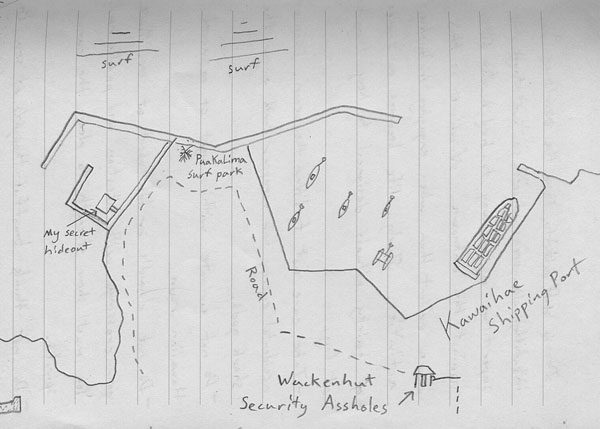
The fifth day I stay put as wind strong catabatic winds blast down off
Mauna Loa and Mauna Kea. I surf a solid 10ft swell at
sunrise, the fifteen foot faces are intimidating to say the
least. Just like the paddling here it takes solid knowledge and
total commitment, because once you go, you gotta go. Hesitate and
you get bombed. I don't hesitate. At sunset the wind
dies enough to surf the falling swell again. I find myself caught
inside (between a wave and a jetty) as a rouge set comes through. I'm
out of adrenaline so I'm just thinking, matter-of-factly, 'I gotta get
outside' as I paddle steadily for the
walls of water, cresting the first, then the second with a bit of a
slap out the backside, and finally the third flatwalls as I paddled
hard up the face. I press my paddle and head hard to the deck and
pierce the lip, opening my eyes as I exit the back of the wave into a
blood red sky, hang in mid air, and splash down.
2/17/07
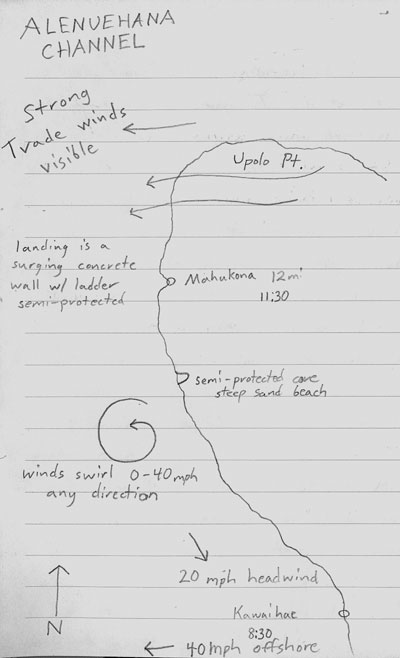
The next day I paddle out into the same 40mph crosswind and fight hard
to keep from being blown out to sea, playing a dangerous game as I
paddle north, flirting with the cliffs and reef to hide from the
wind. I reach my landing at Mahokena to discover that it is
nothing more than a surging concrete wall with a ladder going up.
Getting my kayak and
gear up it is an adventure. Rich meets me
and we drive back to Hilo, scoping out the intimidating Hamakua (north
east) coast. My paddle on the Kona side was a cakewalk compared
to the next two coasts, Hamakua (north) and Kau (south), both exposed
to the full force of the trade winds. Hamakua is home to
the Shark Gods, and Kau home to Pele, lava flowing into the sea.
Tommorow I rest in Hilo and prepare for what I came here for, with
luck, the island and the weather will cooperate. It's hard to
temper my ambitions without being able to see the landing sites.
The ground swell is only 3 feet, but the trade wind swell is 12
feet. Each coast is sixty miles long with only one possible
landing every 20-30 miles. I've never feared big wind chop, but
the
trade swell is really big
wind chop and my lack of experience with it creates
unknown factors. I don't like unknowns. I'll do as much
scoping as I can tommorrow to prepare for a launch and attempt the
north coast on Monday.
Kayaking the Hamakua Coast











